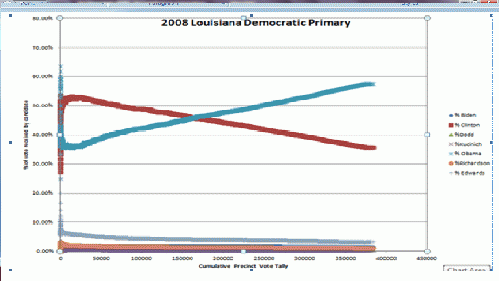In September of 2012, a research study was conducted by Franà �ois Choquette and James Johnson titled 2008/2012 Election Anomalies, Results, Analysis and Concerns. Their research study can be found here.
Their study claimed to find a particular pattern in recorded vote tallies that suggested foul play in the vote count. The pattern they found was that larger precincts tended to favor a particular candidate, for example George Romney. To display the pattern visually they arranged precincts in a state (Ohio) from left to right according to the total number of voters, and plotted the percentage of votes for Romney. In a state with a random distribution of small and large precincts in rural and urban locations, you might expect to see a random, jagged line. But what they found in some cases was a smooth, rising line. Why should precincts that happened to have been mapped with a large number of voters tend so consistently to favor Romney, and why was there so little randomness seen in the line? The authors looked for other explanations and could think of none. They reported their suspicion that someone was rigging the vote tally, and they used an algorithm that flipped more votes in the larger precincts, where they could be better hidden.
"Vote-flipping" is the term used by Choquette and Johnson to describe the fraudulent act of votes being stolen from one candidate and being given to an opposing candidate. For example, the researchers claim that in the 2008 Presidential General Election, vote-flipping took place where John McCain received votes that were cast for Barack Obama. According to the researchers, the anomaly is indicative of vote-flipping.
An interesting claim made in the Choquette-Johnson study stated that: "The Democrat Party elections we looked at don't show this problem." (Choquette & Johnson, 2012 p.) They claim that elections involving the Democratic Party "flat-line," which they consider to be the expected pattern, and indicative of "non-fraudulent" elections. They then state that the anomaly appears only in elections involving the Republican Party exclusively and General Elections. As it pertains to General Elections, according to Choquette and Johnson, the anomaly indicative of vote-flipping always works in the favor of the Republican candidate. In the case of the 2008 General Election, for example, the anomaly worked to the advantage of John McCain.
For a high school class project on research methods, my classmates and I decided to review the findings of Choquette and Johnson. Following the methods outlined in the study, we were able to generate graphs in a fashion similar to that of the work done by the original authors. After performing our analysis, we then went on and wrote up our results and conclusions. Our review of the study can be seen here.
What we found was that this same pattern of trends from smaller to larger precincts could be found in some other election results as well. Our examination of 2008 Democratic Presidential Primary
Elections showed an example of a graph exhibiting the anomaly which Choquette indicated as
only taking place in elections in which the Republican Party is involved. Shown
on the next page in Figure 1 is a graph of the 2008 Democratic Presidential
Primary Election for the State of Louisiana generated by my classmates and me. Obama's votes trend upward (and Clinton's downward), smoothly with increasing precinct size.
Figure 1 : Graph showing the results of the 2008 Democratic Presidential Primary Election for the State of Louisiana. Candidate Clinton is shown in red and candidate Obama is shown in blue.
By comparison, shown below in
Figure 2, is a graph included in the research study done by Choquette and
Johnson. The graph shows the results of the 2012 Republican Presidential Caucus
for the State of Iowa. According to the researchers, this graph exhibits the
"anomaly" with an upward trend being associated with candidate Romney and a
downward trend being associated with the opposing candidates.
Figure 2 : Graph included in the Choquette-Johnson study. The graph depicts the results of the 2012 Republican Presidential Caucus for the State of Iowa.

The trends seen in both graphs
are similar. However, according to the Choquette-Johnson study, elections
involving only the Democratic Party do not show the trend. Figure 1 seems to
contradict this claim made in the original study.
We did not speculate whether the pattern has a natural demographic explanation or whether it is indicative of selective vote-tampering, but we think it is interesting that the pattern is not confined to Republicans
I encourage readers to review the work done by my classmates and me. Please
comment with any thoughts on our response to the Choquette-Johnson study.





